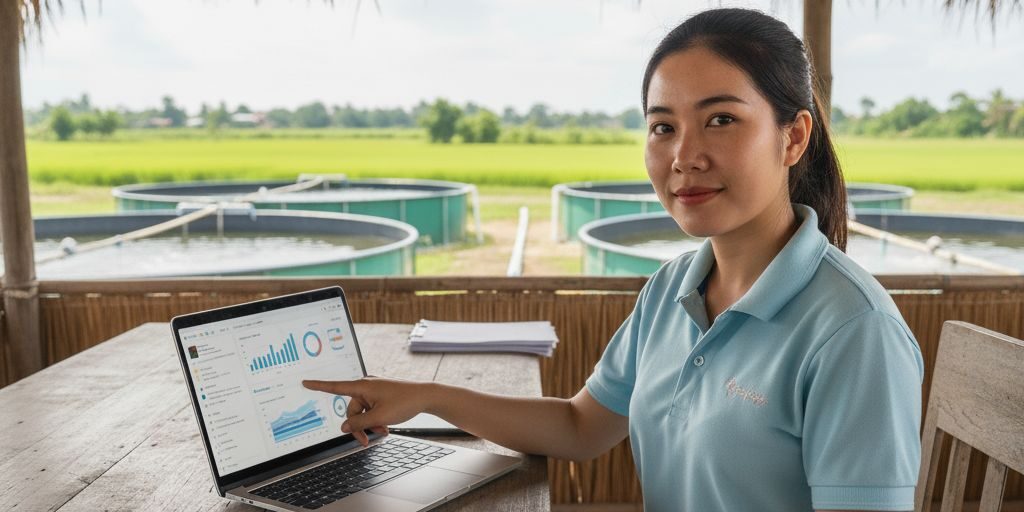- Software Gestor para Aquicultura
- (85) 2139-6730
- contato@despesca.com.br
Brazil Rural Credit Guide

Fish Consumption Trends 2025
18/09/2025
Occupational Safety Standards in Brazilian Aquaculture
22/09/2025Expanding an aquaculture farm in Brazil, whether to increase pond area, modernize equipment, or simply optimize working capital, requires significant investment. Fortunately, there are specific financing lines for the sector available in the country. This Brazil rural credit guide was developed to assist shrimp and fish producers in Brazil in organizing their property’s information professionally, significantly increasing their chances of credit approval with Brazilian financial institutions.
The main barrier for many Brazilian producers is not the lack of credit options but the difficulty in presenting data that proves the viability and financial health of their business. Therefore, organizing information is the first and most crucial step.
What Do Brazilian Banks Really Want to See?
Brazilian financial institutions operate based on risk analysis. To approve financing, the bank needs assurance that the operation is sustainable and that the producer will be able to honor the commitment. In other words, they need concrete and reliable data that demonstrates the efficiency and profitability of your farm, in line with Brazilian agricultural and environmental regulations.
Presenting disorganized information, based on scattered notes or just “memory,” generates distrust. On the other hand, clear and detailed reports show professionalism and deep knowledge of one’s own production. This is particularly important when dealing with the specific requirements of Brazilian banks and government programs.
Essential Data to Present Your Financing Project in Brazil
To build a strong case for a loan in Brazil, your project must be founded on three pillars of information: zootechnical data, financial data, and future planning.
Zootechnical and Production Data:
hese are the indicators that measure your farm’s efficiency. It is essential to have a consistent history of previous cycles.
- Survival Rate: What percentage of animals survive from stocking to harvest?
- Feed Conversion Ratio (FCR): How many kilograms of feed are needed to produce one kilogram of fish? A low FCR indicates high efficiency.
- Daily Weight Gain: Demonstrates the growth speed of the animals.
- Biomasses and Densities: History of stocking density and the total biomass produced per pond or tank.
The collection manual of this data is laborious and prone to errors. The use of a management system like Despesca automates the recording and calculation of these indicators, generating accurate reports with just a few clicks, which are crucial for detailed reporting required by Brazilian financial institutions.
Detailed Financial Data
Financial health ultimately ensures business viability. The Brazilian bank will thoroughly analyze your finances.
- Cost of Production (COP): You need to know exactly how much it costs to produce one kilogram of shrimp or fish in the Brazilian context. Detail costs for post-larvae/fingerlings, feed, labor, electricity, inputs, and maintenance. Understanding your Cost of Production in Shrimp Farming (link to internal Brazilian article, if available) is a competitive advantage.
- Cash Flow: Present a historical cash flow of the property, showing inflows (sales) and outflows (costs and expenses) over time. This is vital for assessing liquidity according to Brazilian accounting standards.
- Revenue and Profitability: Demonstrate the gross revenue from recent cycles and the profit margin achieved, adhering to tax and financial reporting requirements in Brazil.
Planning and Projections, Considering Brazilian Specifics
Based on historical data, you must present a clear plan of how the requested funds will be used and what the expected return is, always considering the specific regulatory environment in Brazil.
- Investment Justification: Be specific. If the credit is for purchasing aerators, for example, explain how this investment will allow an increase in stocking density, resulting in a projected X% increase in production, and how this aligns with environmental licenses and operational permits required in Brazil.
- Formal Quotations: Attach quotations from suppliers for the equipment, inputs, or services you intend to acquire, preferably from Brazilian suppliers or with clear import documentation for Brazilian customs.
- Result Projection: Create a projection of cash flow and profitability for future cycles, already considering the investment and repayment of the financing, and taking into account market conditions and regulatory frameworks in Brazil.
How a Management Software Becomes Your Greatest Ally in Brazil
Presenting all this data in an organized manner can seem like a complex task, but this is where technology makes a difference. An aquaculture management software, such as Despesca, centralizes all the information from your farm in one place, tailored for the Brazilian context.
With it, you no longer rely on spreadsheets and notebooks. The system integrates production data with financial data, offering a complete view of the business. Furthermore, the ability to generate professional and standardized reports is an immense advantage when presenting your project to a Brazilian bank manager. Cycle performance reports, cost analyses, and financial statements extracted directly from a management system transmit an image of organization, control, and seriousness, which are highly valued by Brazilian financial institutions, especially for programs like Pronaf or Pronamp, specific to the country.
In summary, access to rural credit in Brazil depends not only on a good relationship with the bank but also on your ability to prove, with numbers, that your venture is viable and well-managed, adhering to local regulations. Therefore, investing in data organization and management tools is the first step to securing the financing your Brazilian farm needs to grow sustainably.




